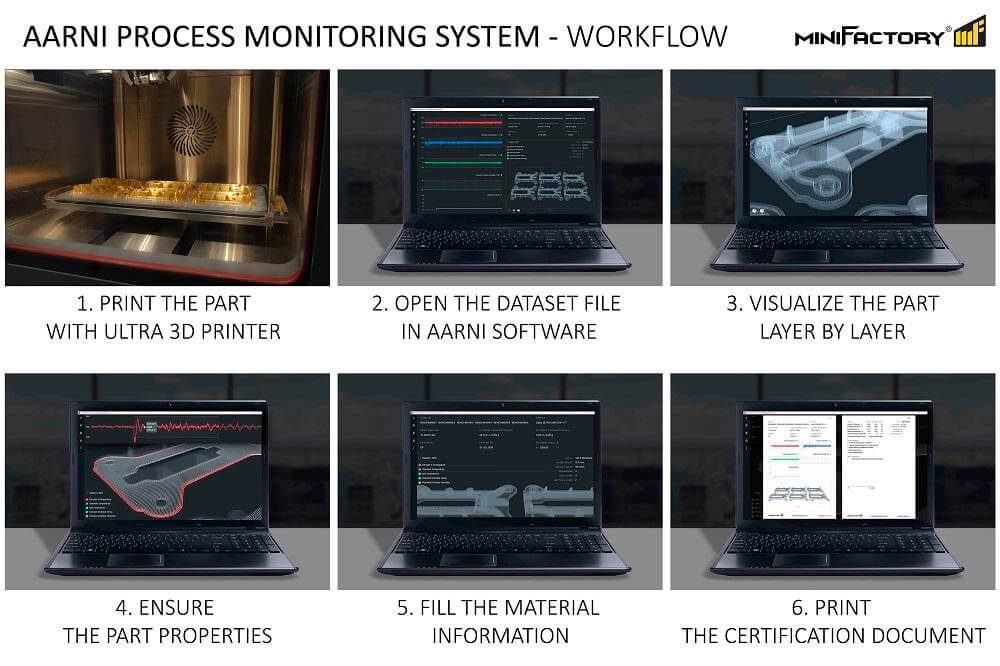Menu
close
Process monitoring is standard practice for all manufacturing methods that produce parts for critical applications.
If 3D printing wants to become a reliable manufacturing method, particular attention must be paid to quality assurance.
3D printing has become increasingly more efficient and it has moved more from prototype manufacturing to production use. Rapid adaptations have also taken place in the materials side. The raw materials of the plastics industry are validated at an increasingly faster pace also in 3D printing. This is enabling companies to use the same material suppliers and materials when they incorporate 3D printing as an alternative manufacturing method.
The production technology and the materials have become comparable to traditional manufacturing methods. Now, the focus is inevitably on the process monitoring and quality assurance, which is likely to be the next major area of development. The need for process monitoring is even more emphasised when printing high-performance polymers that can be used in end products in the space, railway or aerospace industry, for example.
The most common manufacturing methods for polymers are injection molding and machining. With injection molding, it is possible to do thousands of identical parts at a time. This makes the parts easy to test and thus are easy to determine whether the parts are within specification. With injection molding, the part created is uniform and mechanically equally strong in all directions. This method is optimized for the material used and the process temperature is monitored at several measurement points. The strength of injection molding is the capacity for large production batches, however it has high set-up costs since every part needs it’s own molds to be made. All changes often require a completely new mold to be manufactured.
When machining polymers, the parts are machined out of a large block of material until the part has been machined to the desired shape. Machining is suitable for parts that are roughly the size of the blank that is going to be machined. The closer the blank is in size, the less waste is created from removing the excess material. This sets some limitations for the design, thus it makes certain types of parts very expensive to manufacture. The costs caused by the wasted excess material are pronounced when using high-performance polymers since the raw materials used are more expensive compared to engineering polymers.
Compared to machining, 3D printing is an additive manufacturing method, whereas machining is a subtractive manufacturing method. 3D printing offers the ablitiy to manufacture geometries that are challenging or impossible to achieve with traditional methods. It also gives the capability to produce parts on demand, since the the unit cost is not related to the batch size. With additive manufacturing, it is possible to manufacture 10 different parts at a time with almost no material waste. This makes 3D printing a very cost-effective manufacturing method.
In 3D printing, the material is melted in thin layers to the desired shape. The adhesion between the layers is the single most important factor which determines the mechanical strength of a part. Thus it is very important that the printing process can be monitored and verified based on the monitoring data. It's likely that defects are trapped within the part, which makes it impossible to find based on a visual inspection. When inspecting the part visually, only the surface can be seen. It is impossible to determine if the material within has been printed successfully.

Indeed, 3D printing is very different manufacturing process, so the process monitoring must be optimised for the manufacturing method. miniFactory is a forerunner in the field of quality assurance, with the world’s leading material manufacturers, research centres and significant OEM companies among its clients. We listened to our clients’ needs and developed the AARNI process monitoring system. Clients can use it to certify printed parts and verify their high quality. Aarni has been designed to work with our miniFactory Ultra 3D printer.
During printing, the 3D printer stores data automatically every second from several sensors important for the process. After printing, the 3D printer will finalize the dataset automatically into a downloadable file that the the user can take to a computer. On the computer, the user opens the Aarni software and loads the downloaded dataset into the software. Based on the recorded data, Aarni will create a rendered wireframe image of the printed part. With it, user can check the part line-by-line and layer-by-layer.
The software will visually point out any deviations, making them easy to spot. Therefore, the user does not need to manually go through the entire dataset in order to spot the deviations within the part. By default, the Aarni software has automatic presets, which makes it easy to get started with it. If necessary, the user can create their own processes. This is an exceptional tool for working with new materials, or for making absolutely sure that the entire process is impeccable for a printed part in serial production.
The software can be used to inspect one or more parts simultaneously, enabling to certify larger production batches at the same time. AARNI displays all critical printing parameters, and you can also add the LOT number of the printing material. With LOT number, the printed part could be traced all the way to the production batch of the material manufacturer. At the end, the user can save or print an A4-sized document that contains all important information about the manufacturing process of the printed part, and which the operator uses to certify the printed part. Thus, the entire production chain is stored in a single document, just like in traditional manufacturing methods.

Ensure the high quality of printed parts and start your “miniFactory journey” already today. Contact us and book a free 30-minute demo session!
"*" indicates required fields